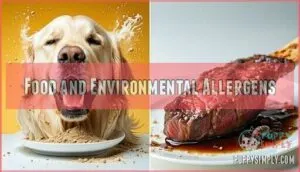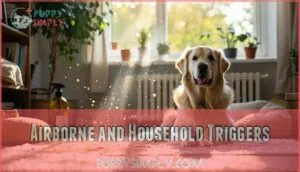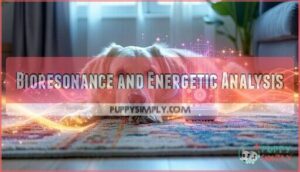This site is supported by our readers. We may earn a commission, at no cost to you, if you purchase through links.

These tests check for food sensitivities like chicken, beef, or grains, plus environmental triggers such as pollen, dust mites, and mold. Popular options include 5Strands and UCARI test kits, which cost $50-150 and provide results within 1-2 weeks.
While convenient, these tests aren’t foolproof—some use questionable methods like bioresonance rather than proven antibody detection. Your vet can perform more accurate blood tests or skin prick tests for definitive results.
Understanding which specific allergens affect your pup helps you make targeted changes to their diet and environment for lasting relief, and this knowledge is key to providing your dog with the best possible care, using at-home kits as a starting point.
Table Of Contents
- Key Takeaways
- Common Dog Allergies and Symptoms
- Top 5 Dog Allergy Test Kits
- How Dog Allergy Tests Work
- Accuracy and Reliability of At-Home Tests
- Diagnosing Atopic Dermatitis in Dogs
- Common Allergens in Dogs
- Allergy Test Results and Treatment
- Consulting a Veterinarian for Allergies
- Frequently Asked Questions (FAQs)
- How do they test your dog for allergies?
- Can a regular vet do allergy testing?
- How does a vet tell if your dog has allergies?
- How much do dog allergy tests cost?
- How long do allergy test results take?
- Can puppies get allergy tests done?
- Are dog allergy tests covered by insurance?
- How often should dogs be retested for allergies?
- Conclusion
Key Takeaways
- At-home tests offer convenient screening but aren’t foolproof – These $50-150 kits can identify potential triggers through hair or saliva samples, but many use questionable bioresonance technology rather than proven antibody detection methods.
- Vet-performed tests provide more accurate diagnosis – Professional blood tests and skin prick tests offer better reliability than at-home options, though they cost $200-300 compared to DIY alternatives.
- Common allergens include beef, chicken, dust mites, and pollen – Food allergens like beef (34% of cases) and chicken (15% of cases) are major culprits, while environmental triggers like dust mites affect 80% of dogs with allergies.
- Results guide targeted treatment changes – Once you’ve identified specific allergens, you can make informed decisions about elimination diets, environmental adjustments like HEPA filters, and immunotherapy that helps 60-80% of dogs.
Common Dog Allergies and Symptoms
If your dog’s constantly scratching, licking, or showing red, irritated skin, they might be dealing with allergies that affect millions of pets worldwide.
Understanding common allergens and recognizing early symptoms can help you identify triggers before they lead to serious skin infections or digestive issues.
Food and Environmental Allergens
Your dog’s immune system can react to various triggers, creating uncomfortable symptoms that affect their daily life.
Common food allergens include beef, chicken, dairy, and wheat, which account for over 90% of reported food allergies in dogs.
Environmental triggers like dust mites affect up to 80% of dogs with environmental allergies, while flea saliva causes 40-60% of allergic dermatitis cases.
Most dogs develop multiple allergen sensitivity, making identification essential for effective treatment.
Airborne and Household Triggers
Beyond your home’s walls, countless invisible triggers can spark your dog’s allergic reactions.
Environmental allergies affect dogs through three main pathways:
- Pollen Exposure – Seasonal tree, grass, and weed pollens that drift indoors
- Dust Mite Control – Microscopic mites thriving in bedding and carpets
- Chemical Sensitivities – Cleaning products, perfumes, and fabric allergens
These airborne allergens and household irritants create year-round challenges, making mold prevention and dust mite management essential for your pet’s comfort.
Clinical Signs of Allergic Reactions
Recognizing dog allergy symptoms helps you take action before conditions worsen.
Watch for persistent scratching, red inflamed skin, and chronic ear infections, which appear in most allergic dogs. Gastrointestinal signs like vomiting and diarrhea occur less frequently but signal food sensitivities.
| Symptom Category | Common Signs | Frequency in Allergic Dogs |
|---|---|---|
| Skin Issues | Itchy skin, hair loss, redness | 85%+ |
| Ear Problems | Infections, discharge, odor | 60% |
| Digestive | Vomiting, diarrhea, upset stomach | 10-15% |
| Respiratory | Sneezing, nasal discharge, coughing | Variable |
At-Home Allergy Test Kits
Since spotting allergy symptoms can feel like detective work, at-home dog allergy test kits offer convenient answers.
These kits use hair samples or saliva to identify triggers through bioresonance technology or antibody detection.
Kit comparisons reveal varying sample types, cost analysis shows $50-200 price ranges, and brand reputation matters for result interpretation.
You can find a variety of options online.
At-home testing provides accessible allergy testing for dogs without vet visits.
Top 5 Dog Allergy Test Kits
Finding the right at-home allergy test can save you time and money while helping identify what’s making your dog miserable.
We’ve reviewed dozens of test kits to bring you the top five options that actually deliver reliable results and clear guidance for managing your pet’s allergies.
1. 5Strands Pet Intolerance Sensitivity Test

Testing 380 items through bioresonance technology, 5Strands analyzes your dog’s hair sample to identify food and environmental intolerances within 5-7 days.
You’ll collect 10-15 hair strands, ship them back, and receive detailed results categorized by severity levels.
While veterinary professionals question the scientific validity of hair-based testing, many pet owners report improved symptoms after following the elimination guidelines.
The thorough report covers proteins, grains, additives, and environmental triggers, making it easier to pinpoint potential problem areas.
Best For: Pet owners dealing with unexplained digestive issues, skin problems, or persistent itching who want a systematic approach to identify potential food and environmental triggers before pursuing costly veterinary testing.
- Comprehensive testing of 380 items including foods, additives, and environmental factors with results delivered within a week
- Many users report noticeable health improvements in their pets after following the elimination guidelines
- More affordable than traditional veterinary allergy testing while providing detailed severity-based categorization of sensitivities
- Lacks scientific validation from peer-reviewed studies, with veterinary professionals questioning hair-based testing accuracy
- Results can be overwhelming and confusing to interpret, requiring significant time and effort to implement dietary changes
- Only identifies intolerances rather than true allergic reactions, potentially missing serious immune system responses that need medical attention
2. UCARI Pet Intolerance Test Kit
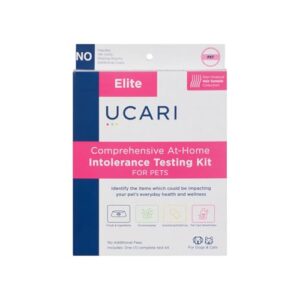
When you’re searching for thorough allergy insights, UCARI’s Pet Intolerance Test Kit delivers fast results that’ll make your head spin.
This kit screens over 1,000 food and environmental triggers using bioresonance technology, requiring only a simple hair sample.
You’ll receive digital results within 48 hours, complete with color-coded severity rankings.
At $69-$99, it’s affordable and convenient, though the scientific backing remains questionable compared to traditional veterinary tests.
Best For: Pet owners seeking convenient, at-home intolerance screening for dogs with suspected food or environmental sensitivities who want quick results without veterinary visits.
- Fast 48-hour digital results with easy-to-read color-coded severity rankings for over 1,000 potential triggers
- Convenient at-home testing requiring only a simple hair sample with no needles or vet visits needed
- Affordable pricing at $69-$99 with comprehensive coverage of food ingredients, environmental factors, and household products
- Bioresonance technology lacks peer-reviewed clinical validation compared to traditional veterinary allergy tests
- Results show intolerances rather than true allergies, which may lead to unnecessary dietary restrictions
- Mixed user reviews report occasional registration issues and questionable scientific reliability for severe conditions
3. DNA Dog Allergy Test Kit

The DNA Dog Allergy Test Kit offers convenience through simple cheek swab collection, analyzing over 120 allergens using ELISA technology.
You’ll receive results within three weeks, identifying food, environmental, and household sensitivities.
While trusted since 2008 by pet owners and vets, mixed reviews question accuracy compared to clinical testing.
The kit includes personalized recommendations and pre-paid return shipping, making it accessible for screening potential triggers before consulting your veterinarian.
Best For: Pet owners seeking a convenient screening tool to identify potential allergens before pursuing veterinary allergy testing.
- Mixed reviews on accuracy with some results not aligning with known allergies
- Should not replace professional veterinary diagnosis and clinical allergy testing
- Potential for sample loss during transit and delays in processing times
- Non-invasive cheek swab collection makes testing simple and stress-free for dogs
- Analyzes over 120 allergens including food, environmental, and household triggers
- Includes personalized care recommendations and food suggestions based on results
4. Dog Food Intolerance Sensitivity Test
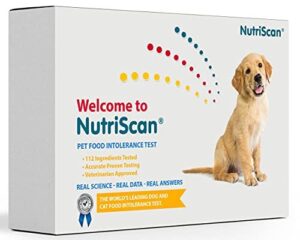
NutriScan stands out as the veterinarian-developed solution that’s making waves in the pet health world.
This clinically proven test measures IgA and IgM antibodies in your dog’s saliva, detecting food sensitivities up to seven months before symptoms appear.
You’ll test 112 food ingredients across 56 different foods, getting results that predict adverse reactions with scientific accuracy.
The kit’s double-testing approach guarantees reliability, while consultation with veterinary professionals adds credibility to your results.
Other tests, like the 5Strands Pet Allergy Test, use bioresonance technology to identify sensitivities.
Best For: Dog owners seeking scientifically-backed food intolerance testing that can detect sensitivities months before symptoms appear, especially those with reactive pets or unexplained digestive issues.
- Limited scientific support within the veterinary community compared to elimination diet trials
- Mixed user experiences with some reporting no improvement despite following recommendations
- May produce false positives or negatives, potentially impacting reliability for clinical decisions
- Clinically proven methodology measuring IgA and IgM antibodies with double-testing for accuracy
- Can predict food reactions 5-7 months before clinical symptoms manifest
- Developed by renowned veterinarian Dr. W. Jean Dodds with veterinary consultation available
5. Pet Intolerance Test for Dogs Cats

Pet intolerance testing for both cats and dogs offers thorough screening across 1,000+ food and environmental triggers using simple hair samples.
You’ll get digital results within days, covering everything from common proteins like chicken and beef to environmental factors such as dust mites and pollen.
The non-invasive process requires no vet visits or blood draws, making it convenient for multi-pet households.
However, mainstream veterinary medicine questions the scientific validity of bioresonance methods, so consider these results as supplementary information rather than definitive diagnosis for your furry companions, and remember that bioresonance is a method that may have limited acceptance.
Best For: Pet owners seeking affordable preliminary screening for chronic symptoms like itching, digestive issues, or skin problems when veterinary testing hasn’t provided clear answers.
- Lacks scientific validation from mainstream veterinary medicine with documented inconsistent results
- Cannot distinguish between true allergies and food intolerances or diagnose life-threatening reactions
- May produce false positives requiring veterinary supervision to confirm suspected triggers through elimination diets
- Non-invasive sample collection using hair and saliva with no vet visit required
- Comprehensive screening of 1,000 food and environmental triggers with quick digital results
- Cost-effective alternative to expensive veterinary allergy testing panels
How Dog Allergy Tests Work
Dog allergy tests work by detecting your pet’s immune system response to specific allergens through different methods.
These tests analyze samples like blood, saliva, or hair to identify which substances trigger allergic reactions in your furry friend, utilizing a process that helps determine the immune system response.
IgE Antibody Detection
IgE antibodies act like your dog’s internal alarm system, detecting specific allergens and triggering reactions.
Serological blood tests measure these circulating antibodies with impressive specificity, though cross-reactivity between similar proteins can create false positives.
Quantitative analysis helps veterinarians distinguish true allergies from background noise, making IgE testing more reliable than intradermal skin testing for busy pet parents.
Many dogs suffer from flea allergy dermatitis, another significant allergen.
Bioresonance and Energetic Analysis
Unlike traditional antibody testing, bioresonance technology uses energetic analysis to assess your dog’s sensitivities through hair samples.
This holistic approach lacks scientific backing, with test limitations including questionable bioresonance validity.
Companies like Glacier Peak use biofeedback devices for their pet sensitivity test, though veterinarians debate this method’s reliability compared to proven diagnostic tools, which raises concerns about the reliability of such methods.
Sample Collection and Processing
Collection simplicity makes at-home testing appealing, but proper handling techniques guarantee accurate results.
You’ll collect hair samples using provided collection tubes, while saliva tests require special swabs.
Storage conditions matter—keep samples cool and dry before shipping.
Follow packaging instructions carefully to prevent sample contamination during transport.
Shipping methods vary by company, with most providing prepaid labels.
Proper sample handling protects result integrity throughout the testing process, ensuring accurate results.
Accuracy and Reliability of At-Home Tests
You’ll find mixed results regarding the accuracy of at-home dog allergy tests, with many veterinarians questioning their reliability.
While these kits offer convenience and quick results, they often lack the scientific validation that professional veterinary tests provide, which can affect their overall accuracy.
Scientific Evidence and Criticisms
While understanding how at-home dog allergy tests work matters, their test validity remains questionable.
Most lack scientific backing from clinical trials, leading to concerning result accuracy issues.
Key Scientific Concerns:
- False positive test results occur frequently in healthy, non-allergic dogs
- Dog allergy test studies show poor reproducibility between duplicate tests
- Test accuracy varies dramatically across different brands and methods
- Clinical relevance questions arise from veterinary dermatology associations
- Dog allergy test accuracy doesn’t match established medical protocols consistently
Vet-Recommended Tests
Veterinarians strongly recommend Intradermal Testing and Serum IgE blood tests over at-home kits for accurate allergy diagnosis.
RAST Testing and ELISA methods provide reliable results that guide effective immunotherapy. Most veterinary dermatologists prefer these vet-recommended tests because they’re scientifically validated, unlike many commercial sensitivity kits that lack proper clinical evidence for reliable allergy testing in dogs.
These tests help identify common environmental triggers that affect dogs.
Limitations of At-Home Kits
At-home testing faces significant hurdles that can mislead you.
False positives occur frequently because unproven technology like bioresonance can’t reliably analyze hair samples.
Limited allergen lists miss key triggers, while interpretation difficulty leaves you guessing about results.
Sample integrity issues affect test reliability, making the lower test cost seem less appealing when accuracy suffers.
Addressing gut imbalances can also be essential, as issues can be identified through a dog microbiome test, which is crucial for understanding gut health and microbiome balance, and ultimately, allergen triggers.
Diagnosing Atopic Dermatitis in Dogs
If your dog constantly scratches, develops red patches, or suffers from recurring ear infections, they might’ve atopic dermatitis—a chronic allergic skin condition that affects up to 15% of all dogs.
Getting an accurate veterinary diagnosis involves ruling out other skin issues through physical exams, allergy testing, and sometimes elimination diets to pinpoint the specific triggers causing your pup’s discomfort.
Signs of Atopy
You’ll spot atopy when your dog can’t stop scratching, especially around their face, paws, and ears.
Watch for excessive paw licking, constant facial rubbing against furniture, and patchy hair loss from persistent itching.
This allergic skin disease often triggers secondary infections, making your dog’s skin inflammation worse and requiring a proper dog allergy test for diagnosis.
You should also watch for noticeable behavior changes, as these can also indicate health issues.
Veterinary Diagnosis
Professional veterinary diagnosis requires systematic clinical examination and allergy history documentation.
Your vet will perform differential diagnosis, ruling out parasites, infections, and other skin conditions before confirming atopy.
Diagnostic imaging isn’t typically needed for canine allergy test procedures.
Veterinarian expertise guarantees accurate interpretation of allergy testing dogs results, distinguishing between environmental sensitivities and food allergies through thorough evaluation.
Common Allergens in Dogs
Your dog’s immune system can react to dozens of common substances found in food, air, and around your home.
Understanding these allergens helps you identify what’s triggering your pet’s uncomfortable symptoms and guides you toward the right testing approach.
Food Allergens
Food allergens trigger most adverse reactions in sensitive dogs, with certain proteins causing 90% of documented cases.
Your dog’s immune system can develop sensitivities to common ingredients over time, making elimination diets essential for proper diagnosis.
The most problematic food allergens include:
- Beef – affects 34% of food-allergic dogs
- Dairy products – responsible for 17% of reactions
- Chicken – triggers allergies in 15% of cases
- Wheat – causes 13% of food sensitivities
- Soy and lamb – account for additional reactions
It’s important to note that beef is a common allergen in dog food. Novel proteins and hydrolyzed proteins in specialized diets help manage food intolerances by providing alternatives your dog’s gut microbiome hasn’t encountered before.
Environmental Triggers
Environmental allergens create year-round challenges for your dog’s immune system.
Dust mites thrive in carpets and bedding, affecting up to 80% of dogs with environmental allergies.
Mold spores peak during humid seasons, while household irritants like cleaning products and fragrances trigger reactions.
Effective flea control remains critical since flea saliva causes widespread allergic dermatitis in sensitive dogs.
Seasonal and Perennial Allergens
While seasonal allergies peak during pollen seasons, your dog might face Year-Round Symptoms from dust mites and molds.
These environmental allergens create ongoing challenges that require consistent management strategies.
Key seasonal and perennial triggers include:
- Spring pollens from trees like ragweed and Bermuda grass
- Mold Exposure during humid fall months
- Dust Mite Control needs throughout winter indoors
Flea Prevention remains essential year-round, as flea saliva causes 40% of allergic dermatitis cases.
Allergy Test Results and Treatment
Once you’ve got your dog’s allergy test results in hand, you’ll need to decode what those numbers and categories actually mean for your furry friend’s daily life.
The real magic happens when you translate those findings into actionable treatment plans, whether that’s switching to a hypoallergenic diet, starting immunotherapy shots, or simply keeping those pesky dust mites at bay.
Interpreting Test Results
Reading your dog’s test results feels like decoding a medical report, but it’s simpler than you’d think.
Understanding IgE levels helps identify allergen identification patterns, while colorcoded reports show allergy severity from mild to severe.
Watch for false positives—up to 20% of results aren’t clinically significant.
Focus on actionable steps by correlating test results with your dog’s actual symptoms for accurate antibody reactivity assessment and long-term management planning.
Immunotherapy and Dietary Changes
Once you’ve identified your dog’s triggers, immunotherapy offers long-term relief through allergy shots that gradually desensitize their immune system.
Approximately 60-80% of dogs show significant improvement with this treatment.
Many owners explore options for dog allergy relief to manage their pet’s symptoms.
For food allergies, you’ll need an elimination diet featuring novel proteins like venison or hydrolyzed protein formulas that support gut health through targeted supplementation.
Environmental Adjustments
Once you’ve identified your dog’s specific allergens, targeted environmental adjustments can dramatically reduce exposure and provide relief.
Simple changes around your home create a safer, more comfortable space for your allergic pup.
- Dust Mite Control: Wash bedding weekly in hot water and use allergen-proof covers on dog beds to minimize dust mite exposure
- Pollen Reduction: Limit outdoor activities during peak pollen seasons and wipe paws after walks to remove allergens
- Air Purification: Install HEPA filters in your home’s ventilation system to capture airborne pollens and household items
- Mold Remediation: Use dehumidifiers in damp areas and guarantee proper ventilation to prevent mold spore buildup
- Flea Prevention: Maintain year-round flea control programs and vacuum frequently to eliminate flea eggs and larvae
To further minimize allergens, consider using specialized bedding products.
Consulting a Veterinarian for Allergies
While at-home allergy tests offer convenience, they can’t replace professional veterinary evaluation when your dog’s symptoms persist or worsen.
Your vet can perform more accurate diagnostic tests, rule out other conditions, and create thorough treatment plans that include prescription medications, immunotherapy, or specialized diets.
When to Seek Professional Help
When your dog’s allergy symptoms become severe or unresponsive to basic treatments, it’s time for veterinary consultation.
Persistent scratching, recurring infections, or emergency signs like facial swelling demand professional allergy diagnosis.
If uncertain results from your dog allergy test leave you puzzled, or if allergy testing reveals complex triggers, veterinarians provide accurate allergy diagnosis and targeted treatment plans.
Allergy Supplements and Hypoallergenic Foods
Your vet might recommend omega-3 supplements for allergy relief dogs, with fish oil showing improvement in 41% of cases after 4-6 weeks.
Hypoallergenic dogs benefit from limited-ingredient diets and novel proteins like venison or duck.
Food allergy dogs need careful ingredient sourcing—18% of hypoallergenic dog diet labels contain undisclosed proteins, making supplement efficacy monitoring essential for food allergies.
Pet Emergency Care and Allergies
Severe allergic reactions can turn life-threatening fast.
When allergies strike, every second counts.
Anaphylactic shock causes breathing difficulty and swollen airways within minutes of exposure.
You’ll see facial swelling, vomiting, or collapse – get to your emergency vet immediately.
Don’t wait for antihistamine overdose symptoms to worsen.
Emergency symptoms require oxygen support and epinephrine injections that only veterinary facilities provide for effective allergy relief dogs need.
Frequently Asked Questions (FAQs)
How do they test your dog for allergies?
Vets use two main methods: intradermal skin testing (injecting allergens under the skin) or blood tests measuring IgE antibodies. At-home kits test hair or saliva samples using bioresonance technology.
Can a regular vet do allergy testing?
Most surprisingly, your regular vet can perform some allergy tests! They’ll handle blood tests measuring IgE antibodies, but intradermal skin testing typically requires a veterinary dermatologist’s expertise.
How does a vet tell if your dog has allergies?
Your vet diagnoses allergies by examining symptoms like itching, skin irritation, and ear infections, then conducting tests including blood work, intradermal skin testing, or elimination diets to identify specific triggers.
How much do dog allergy tests cost?
Allergy testing costs vary by method.
Blood tests and intradermal skin testing typically run $200-$300 at your vet’s office.
At-home test kits offer a budget-friendly alternative, ranging from $50-$150 depending on allergens tested.
How long do allergy test results take?
Tests typically take 5-7 days for at-home kits, while vet-performed blood tests deliver results in 2-3 weeks, giving you answers faster than your dog’s next grooming appointment.
Can puppies get allergy tests done?
Most puppies can receive allergy tests after six months of age, though many vets recommend waiting until they’re at least one year old.
Young immune systems are still developing, which can affect test accuracy and reliability, making it important to consider the timing of such tests to ensure reliability.
Are dog allergy tests covered by insurance?
Picture yourself opening your wallet only to find moths flying out – that’s what happens when you discover most pet insurance plans don’t cover allergy testing, viewing it as preventive care rather than essential treatment.
How often should dogs be retested for allergies?
You’ll typically need to retest your dog every 2-3 years, since allergies can develop or change over time. However, if symptoms worsen or new ones appear, don’t wait—retest sooner.
Conclusion
While your furry detective mightn’t appreciate being poked and prodded for science, a dog allergy test can transform both your lives from constant scratching to peaceful napping.
These at-home kits offer convenient first steps, though they’re not perfect substitutes for veterinary testing.
You’ll get valuable insights into potential triggers, but remember that false positives happen.
Start with a reputable kit, discuss results with your vet, and prepare for some trial-and-error adjustments to your pup’s environment and diet for ideal relief.

